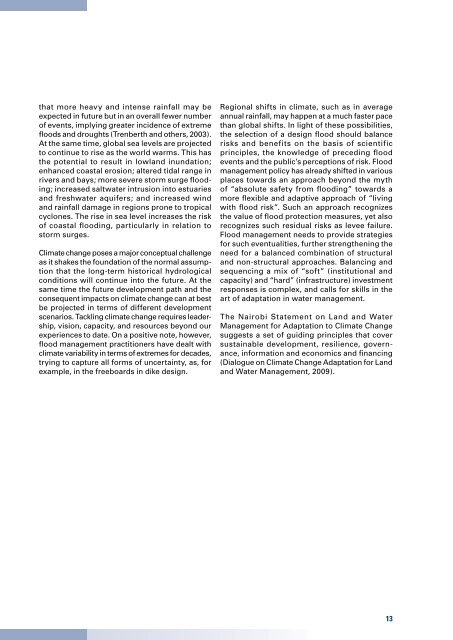Integrated Flood Management-Concept Paper.pdf - APFM
Integrated Flood Management-Concept Paper.pdf - APFM
Integrated Flood Management-Concept Paper.pdf - APFM
Create successful ePaper yourself
Turn your PDF publications into a flip-book with our unique Google optimized e-Paper software.
that more heavy and intense rainfall may be<br />
expected in future but in an overall fewer number<br />
of events, implying greater incidence of extreme<br />
floods and droughts (Trenberth and others, 2003).<br />
At the same time, global sea levels are projected<br />
to continue to rise as the world warms. This has<br />
the potential to result in lowland inundation;<br />
enhanced coastal erosion; altered tidal range in<br />
rivers and bays; more severe storm surge flooding;<br />
increased saltwater intrusion into estuaries<br />
and freshwater aquifers; and increased wind<br />
and rainfall damage in regions prone to tropical<br />
cyclones. The rise in sea level increases the risk<br />
of coastal flooding, particularly in relation to<br />
storm surges.<br />
Climate change poses a major conceptual challenge<br />
as it shakes the foundation of the normal assumption<br />
that the long-term historical hydrological<br />
conditions will continue into the future. At the<br />
same time the future development path and the<br />
consequent impacts on climate change can at best<br />
be projected in terms of different development<br />
scenarios. Tackling climate change requires leadership,<br />
vision, capacity, and resources beyond our<br />
experiences to date. On a positive note, however,<br />
flood management practitioners have dealt with<br />
climate variability in terms of extremes for decades,<br />
trying to capture all forms of uncertainty, as, for<br />
example, in the freeboards in dike design.<br />
Regional shifts in climate, such as in average<br />
annual rainfall, may happen at a much faster pace<br />
than global shifts. In light of these possibilities,<br />
the selection of a design flood should balance<br />
risks and benefits on the basis of scientific<br />
principles, the knowledge of preceding flood<br />
events and the public’s perceptions of risk. <strong>Flood</strong><br />
management policy has already shifted in various<br />
places towards an approach beyond the myth<br />
of “absolute safety from flooding” towards a<br />
more flexible and adaptive approach of “living<br />
with flood risk”. Such an approach recognizes<br />
the value of flood protection measures, yet also<br />
recognizes such residual risks as levee failure.<br />
<strong>Flood</strong> management needs to provide strategies<br />
for such eventualities, further strengthening the<br />
need for a balanced combination of structural<br />
and non-structural approaches. Balancing and<br />
sequencing a mix of “soft” (institutional and<br />
capacity) and “hard” (infrastructure) investment<br />
responses is complex, and calls for skills in the<br />
art of adaptation in water management.<br />
The Nairobi Statement on Land and Water<br />
<strong>Management</strong> for Adaptation to Climate Change<br />
suggests a set of guiding principles that cover<br />
sustainable development, resilience, governance,<br />
information and economics and financing<br />
(Dialogue on Climate Change Adaptation for Land<br />
and Water <strong>Management</strong>, 2009).<br />
13
















